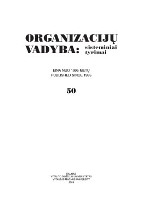Lietuvos nekilnojamojo turto rinka – ekonominės sistemos raidos išdava
LITHUANIAN REAL ESTATE MARKET AS A RESULT OF ECONOMIC SYSTEM DEVELOPMENT
Author(s): Ieva KvedaravičienėSubject(s): Economy
Published by: Vytauto Didžiojo Universitetas
Keywords: nekilnojamasis turtas; NT rinkos funkcionavimas; komandinis ūkis; rinkos mechanizmas; real estate; real estate market functioning; distribution mechanism; market mechanism.
Summary/Abstract: Real estate market is usually analyzed in terms of the supply and demand factors’ definition and estimation in a certain geographical area at a certain period of time. Moreover, local real estate markets are often compared with markets of other countries, usually similar in size. Market activity, price dynamics, market maturity are traditionally the key factors for real estate market research. The importance and significance of market maturity suggests to discuss the following issue: can we reasonably compare several markets representing different level of maturity? Part of the usually compared countries (in most cases Scandinavian countries) have formed significantly earlier than Lithuanian real estate market and, moreover, operate under different conditions over a long period of time if compared with the whole existence of Lithuanian (and the Baltic states) market. Therefore, it is relevant to analyze the functioning of Lithuanian real estate market and make forecasts taking into consideration fundamental differences of markets, that have formed mainly due to different surrounding (economic) systems. This could help to reduce inaccuracy of any forecasts that are so important for market participants’ expectations and decisions. A qualitative market formation analysis was performed by reviewing and comparing two real estate distribution mechanisms - Soviet era distribution-based mechanism and market economy-based mechanism – and their major elements (property rights, participants, functioning of distribution mechanism, environment). The analysis provided the following conclusions: • In almost twenty years Lithuanian real estate market and its residential segment have been developing very fast. The residential real estate distribution mechanism improved significantly and currently matches characteristics of market economy distribution mechanism. • Recently, first of all due to economic recession, inconformity between purchasing power and real estate prices forms a clear demand for financial intermediation. An effective demand is minimal and has very low impact on the functioning of real estate market. • Despite the distribution mechanisms characteristics, most of which meet the market mechanism criteria, it is irrelevant to compare homologous different markets, which have formed in totally different economic systems and were functioning under different conditions. This suggests applying different patterns for prognosis. Major part of the residential property fund represents very low quality (more than 60 % of total residential property was build in the period of 1961-1990), and forms need to renovate old buildings and build the new ones. The volume of the above mentioned need may have impact on the growing demand for financing, and shall fasten the recovery of real estate market and general economy more quickly and significantly than in matured markets, where qualitative parameters of real estate meet the needs of the majority market partici
Journal: Organizacijų vadyba: sisteminiai tyrimai
- Issue Year: 2009
- Issue No: 50
- Page Range: 83-90
- Page Count: 8
- Language: Lithuanian

